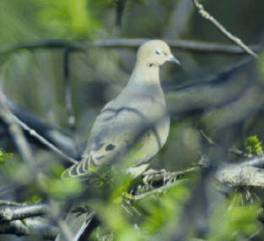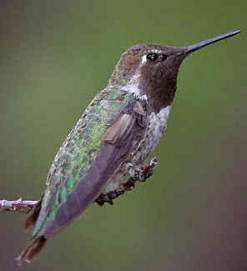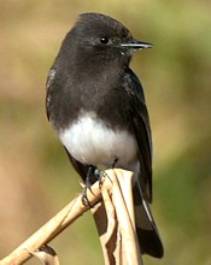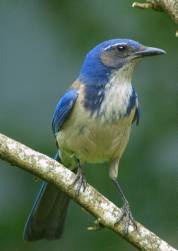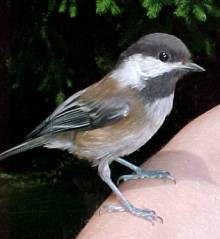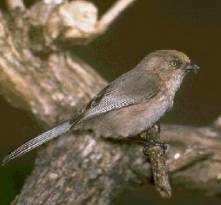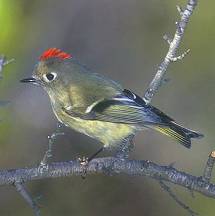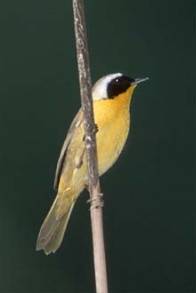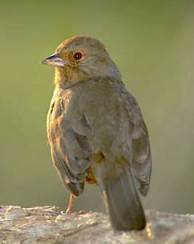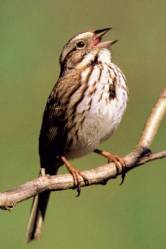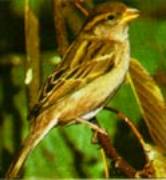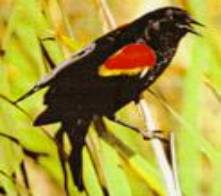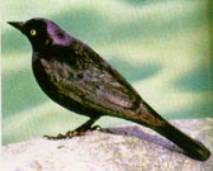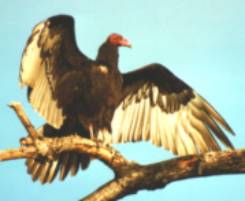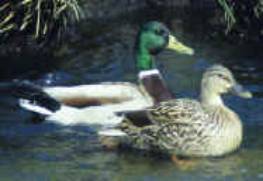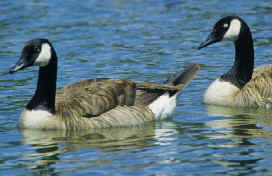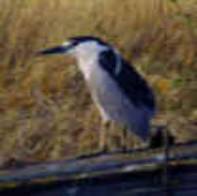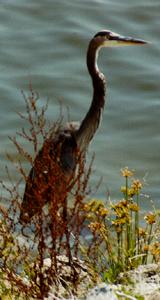Birds
|
Morning Dove
Zenaida macroura
This common dove is
gray-brown with a black spot on its cheeks.
It has a slim body, small head, pinkish feet, and a long pointed
tail. The wings produce a whistling sound as the dove takes flight and the
white tips of the outer tail feathers are visible.
Small flocks are often found feeding on the ground or perched on
wires or tree branches. Its flight is swift and direct without coasting.
Its call is a series of mournful coos.
It lays 2 white eggs in nests in trees, shrubs, or on the ground.
12 inches long. |
|
|
|
This hummingbird is the largest California hummingbird and is the only one commonly found here during midwinter. It is dark green above and gray below. Males have a brilliant red crown and red-spotted throat. Females often have a few red throat feathers and a white-tipped tail. Its song, delivered from a perch, is a series of squeaking, rasping notes; its call is a sharp chick. It lays 2 white eggs in a tiny lichen-covered cup fastened to a branch of a tree or shrub. 3-4 in. |
|
The black
phoebe is a solitary flycatcher that feeds almost entirely on flying
insects. It
perches in the open near water, wagging and spreading its tail. It
makes short flights to catch insects, and returns to its perch. The top of
its body, including the breast, is black; the belly is white. Its
4-syllable song is a thin, rising pee-wee, followed by a descending
pee-wee. Its calls
include a loud tsee and a sharper tsip.
It lays 3-6 white eggs in a cup nest of mud and grass built beneath
an overhanging cliff or eave. 6-7 in. |
|
|
|
|
|
The
chestnut-backed chickadee has a brown cap, white cheeks, and a black bib.
It feeds high in trees, sometimes hanging upside down.
Its call is a hoarse, rapid tseek-a-dee-dee.
It lays 5-7 dotted eggs in a cavity in a tree or stump. 5 in.
|
|
|
|
RESIDENT |
|
The ruby-crowned
kinglet is a tiny, plump, active, nervous bird.
It flicks its wings rapidly while singing a high, thin tsee,
or scolding je-dit je-dit. It
is grayish-olive above, with two white wing bars. The male flashes its red crown patch when upset. |
|
|
|
This
small wren-like warbler has olive-colored upper parts and yellow
underparts. The male has a
black mask, bordered above by white, that wraps across the top of its bill
and around the front of the head. The
yellowthroat is often found on or near the ground in dense patches of
tules and cattails in marsh habitats.
Its song, witchity, witchity, witchity, witch,
is repeated several times. It
lays 3-5 spotted eggs in a loose grass cup.
5 in. |
|
The California towhee is dull brown
above, paler below, and has a dark-streaked buffy –throat. It has a long
tail with rusty orange undertail
coverts. This common bird
hops while feeding on the ground near dense shrubbery.
Its call is a metallic chink. The cup nest is built in a
bush or low tree and contains 3-4 spotted eggs.
8 in. |
|
|
|
RESIDENT The song sparrow is
brown with a heavily streaked breast and a central dark “stickpin”.
Its legs and feet are pinkish. It
pumps its long, rounded tail in flight. It inhabits dense streamside
thickets and moist wood margins. Its song is a series of variable
musical and buzzy notes: sweet, sweet, sweet.
Its call note is a hollow chimp. It lays 3-5 spotted eggs
in a grass cup on the ground or in a bush.
6 in. |
|
English House
Sparrow
Passer domesticus This small bird is very friendly and is well known for its adaptation to city environments. The male is brown and gray with a black face mask. The female is plain brown. They were introduced into this area by European settlers who wanted to bring a piece of home with them. They thrive on insects and occasionally on refuse left by people visiting the area. |
|
|
|
This bird is found in the area year round. The males have bright red shoulder patches against a black body. These patches are hidden when feeding or resting and can only be seen when in flight. The female is brown with dark stripes. The males and females form separate except during the breeding season. They feed on plants and insects. |
|
|
|
|
|
|
|
This Mallard is a common duck found in
this area. The males have a green head, white neck ring, and rusty
colored breast. The female is a mottled brown color. The
Mallards near Stivers Lagoon
are a mix of wild and domestic birds. The wild birds are smaller and
have the ability to fly gracefully from a standstill. The
domesticated birds are hybrids due to their varying body weight of the birds they fly as
well as the wild birds. These birds feed on the surface of the
water, when searching out food they tip and only their tail feathers will
show. |
|
|
|
Northern Shoveler
Anas clypeata A common marsh duck distinguished by it's large spatula shaped bill. The male has a green head, yellow eye, white breast, and brown sides. The female has mainly brown coloring with green speculum on it's wings. It is 19 inches long. |
|
This goose is found year round in the park area. They are identified by their long black necks and white cheek strap. They are brown on top and whitish below. Both male and female look the same in shape size and color. They feed on the grass that lies in the open fields around the park area. They fly well and are seen around town flying in the typical "v" formation. |
|
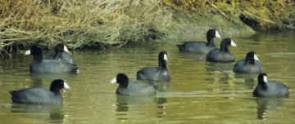 |
This
chicken-sized bird is slate black with red eyes and a white
bill. Its feet are lobed to enable efficient walking and
swimming. They feed on lake vegetation and also the lawns of the park. |
|
|
|
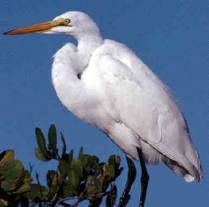 |
This Great Egret is a large, slender, white bird that stands at about three feet tall. It has a long pointed yellow beak used to spear fish, its main food source. They have black feet and legs. They wade into fairly deep water to search out food. When they fly, their necks are pulled back into an "S" curve. |
|
The Great Blue Heron is the largest long-legged wading bird found in our area. It is nearly four feet tall and its wingspan is almost six feet. The yellow beak is shaped like a dagger. They have a whitish head and a blue gray body. When seen flying they form a loose "S" curve with their neck. Their diet consists of frogs, fish, crayfish, mice, insects, and occasionally very young waterfowl.
|
|
